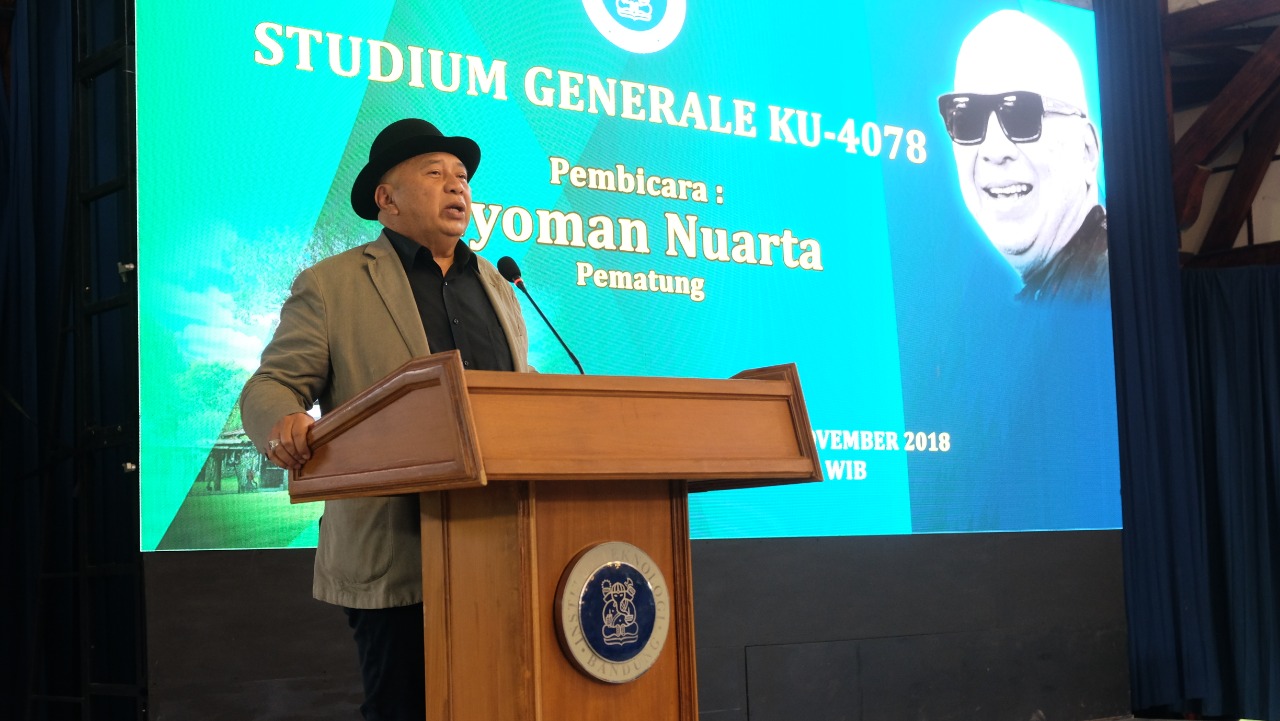I Nyoman Nuarta: The Maestro Behind the Magnificence of Istana Garuda IKN
By Anggun Nindita -
Editor Anggun Nindita

BANDUNG, itb.ac.id - One of the buildings that will become an iconic landmark of the government center in the new capital city (IKN) is the Garuda Palace. The Garuda Palace will serve as the president's office in IKN. President Joko Widodo himself named the Garuda Palace.
Meanwhile, the Presidential Palace Complex in IKN will be known as the State Palace.
The Garuda Palace features a unique and meaningful design. The building combines traditional and modern elements, representing the dynamic and evolving identity of the nation.
Behind the beauty of the Garuda Palace is the name Nyoman Nuarta, a sculpture maestro and graduate of Institut Teknologi Bandung (ITB). He has successfully integrated the noble values of the Indonesian nation into every detail of the Garuda Palace's design.
Nyoman Nuarta's Life Journey
I Nyoman Nuarta was born on November 14, 1951, in Tabanan, Bali. He is the sixth of nine children born to Wirjamidjana and Samudra. His artistic spirit began to grow when he was nurtured by his uncle, Ketut Dharma Susila, an art teacher.
After graduating from high school, Nyoman Nuarta pursued his education at ITB in 1972. Initially, he chose the painting department, but after a year, he switched to sculpture.
He found sculpture more unique because it allowed for the creation of three-dimensional works and had a more interesting and dynamic process.
Nyoman Nuarta's Masterpieces
In 1979, he began to show his achievements by winning the Proclamator of the Republic of Indonesia Statue Competition. To date, Nyoman Nuarta has created over a hundred sculptures. Almost all his works depict modern sculpture to naturalistic styles.
This Indonesian sculpture maestro has created numerous monumental works that have become national icons. One of his early works is the Jalesveva Jayamahe Monument in Surabaya, which embodies the fighting spirit of the Indonesian Navy.
His most famous work is the Garuda Wisnu Kencana (GWK) statue in Bali. The implementation of the culturepreneur concept and a realist-figurative approach in the development of GWK is a testament to his significant contribution to the field of fine arts.
Now, he has once again been entrusted to design the Garuda Palace in IKN.
The "Archsculpt" Concept in Garuda Palace IKN

Behind the grandeur of the Garuda Palace IKN, he successfully integrated the noble values of the Indonesian nation into every detail of the Garuda bird design, the symbol of the nation.
The use of the Garuda bird symbol creates an iconic impression and attracts tourists. According to Nyoman Nuarta, this also has the potential to boost the growth of local hospitality, transportation, travel agencies, souvenir shops, and small industries.
"For the Garuda Palace, I proposed the archsculpt concept, which combines sculpture with architecture. Just as great artists like Michelangelo, Leonardo da Vinci, and I Gusti Nyoman Lempad did with buildings such as churches and temples, I created the Garuda Palace with two functions," he said, quoted from the 101 Years of PTTI book.
First, the aesthetic function. Like GWK, the Garuda Palace will be a monumental work of art representing the figure of the Garuda bird. Since it was introduced by President Soekarno on February 11, 1950, Garuda Pancasila has been a symbol of Indonesia that unites a diverse nation of different ethnicities, religions, and languages. The phrase "Bhinneka Tunggal Ika" (Unity in Diversity) at the base of the Garuda reinforces this sense of unity. Although initially political, Garuda Pancasila was also inspired by the Sutasoma book by Mpu Tantular during the Majapahit era. Furthermore, the phrase "Bhinneka Tunggal Ika" emphasizes Indonesia as a unity of cultural mosaics that form the Indonesian nation.
Second, the pragmatic function, where the Garuda Palace will serve as the office for the President of Indonesia to manage daily government affairs. "The building is designed with a green design concept. The Garuda figure will be formed from vertical copper blades that also function as sunshades to prevent the greenhouse effect. The glass walls can be opened for air circulation, reducing the use of air conditioning and increasing energy efficiency," he explained.
Copper was chosen as the main material due to its flexible, corrosion-resistant, and easily shaped properties. Additionally, copper is resistant to moss or mold growth, minimizing maintenance disruptions to state activities.
Copper also serves as a good conductor, forming a Faraday cage to shield against electricity and lightning, and preventing fires caused by static electricity. This model has been applied to the GWK building in Bali and functions well.
"These two functions, aesthetic and pragmatic, are the achievements of the archsculpt concept I proposed. I have long experimented with combining the aesthetic function of art with the pragmatism of buildings. The Garuda Palace not only functions as a government building but also as a symbol of unity and beauty that soothes the people," he said.
The Garuda Palace is a tangible proof of Nyoman Nuarta's work in creating iconic buildings that combine traditional and modern values. With its beautiful design and profound meaning, the Garuda Palace is expected to become a symbol of Indonesia's resurgence and an inspiration for future generations.

.jpg)

.jpg)



